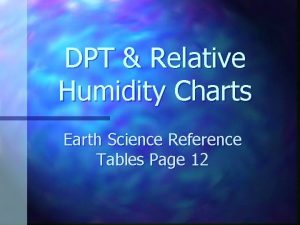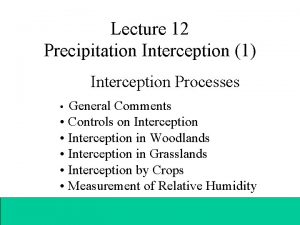Rainfall Minima during Periods of High Relative Humidity

- Slides: 1

Rainfall Minima during Periods of High Relative Humidity in Tropical Maritime Regions Scott W. Powell, Naval Postgraduate School, Monterey, CA 2. Radar Data 1. Introduction Dependence of tropical maritime precipitation on tropospheric humidity is well understood. Many observational 1, 2 and modeling 3, 4, 5, 6 studies have indicated that deepening of tropical convection is most sensitive to water vapor in the lower half of the troposphere. I utilized radar data from three locations. Three datasets were collected during DYNAMO in the central Indian Ocean, and one is the NASA KPOL radar at Kwajalein Atoll. S-Pol. Ka and KPOL were/are dual-polarized. The radar data were used to estimate rain rate. Top, left: CRH vs radar-derived rain rates. The red lines denote the 10 th and 90 th percentiles of rain rate as a function of CRH. Bottom, left: Picture taken from R/V Thompson during PISTON on 7 Sept 2018 at 0230 UTC. Bottom, right: Sounding from 0230 UTC 7 Sept 2018. However, often times, little or no rain occurs when the atmosphere is very moist. Why? Some possibilities, although not all: - Increased static stability above boundary layer - Less favorable wind/shear profiles - Lower sea surface temperature or gradient - Less boundary layer convergence - Unfavorable cloud properties, such as cloud size or vicinity of updraft to edge of cloud and environmental air Cloud population in a very moist environment (see sounding) Figure 1: Locations of radars used so far in this study. Rain-type classification 7 was run on the reflectivity data, and rain rate was computed using dual-pol data if possible 8. Picture from E. Maloney (Colo. State) 4. Areal Coverage of Precipitation vs. Rain Rate d) Isolated Convection 3. Visualizing the Question Left: Radar-derived mean rain rates as a function of the fraction of the radar domain experiencing precipitation (reflectivity ≥ 7 d. BZ). In panels a, b, c, and d, respectively, areal coverage of all echo, convective echo, stratiform echo, and isolated echo is plotted. Darker shades of blue indicate higher area coverages of convective rainfall. The rain rates shown occurred only when CRH exceeded 0. 8. 5. Environmental Characteristics Left: Mean sounding profiles during upper quartile of echo areal coverage minus mean profiles during the lower quartile. The colored lines denote results from different sites, and the black line is the composite. Shading represents the 95% confidence interval. Below: Table derived from ERA-I reanalysis of SST and SST gradient at the radar site during times when echo areal coverages were less than (greater than) low and high quartiles. The part of the convective lifecycle (e. g. early convective or mature stratiform) observed in the radar domain is one factor in the spread of rain rates at high CRH. If echo covers half the domain, but all of the echo is stratiform, then radar-domain mean rain rate will be small. However, sometimes total areal coverage is near 0. What causes little to no echo to occur when CRH is high? 7. References 1 Brown and Zhang (1997), JAS, 54, 2760– 2774 6. Next Steps Rawinsonde data were co-located with each of the radar datasets. I used these data to compute kinematic and thermodynamic properties of the troposphere. Rawinsonde data was matched with radar data collected within 1. 5 hours of launch. Not surprisingly, a positive correlation existed between areal coverage of rainfall and domainmean rain rate. However, even when areal coverage exceeded half the domain (panel a), rain rate ranged from near 0 to near 4 mm hr-1. On the other hand, radar-derived rain rate was strongly correlated with the fraction of the domain experiencing convective rainfall. SST (low) (K) 3 Derbyshire et al. (2004), QJRMS, 130, 3055– 3079, doi: 10. 1256/qj. 03. 130 5 Kuang (2010), JAS, 67, 941– 962, doi: 10. 1175/2009 JAS 3260. 1 6 Wang and Sobel (2012), JGR-Atmos. , 117, doi: 10. 1029/2011 JD 016847 7 Powell et al. (2016), J Tech. , 33, 523– 538, doi: 10. 1175/JTECH-D-15 -0135. 1 8 Thompson et al. (2018), JAMC, 57, 755– 775, doi: 10. 1175/JAMC-D-0160. 1 9 Bretherton et al. (2004), J. Climate, 17, 1517– 1528 10 Rushley et al. (2018), GRL, 45, 1133– 1140, doi: 10. 1002/2017 GL 076296 S-Pol. Ka Mirai Revelle KPOL [302. 03, 302. 08] [302. 10, 302. 26] [301. 95, 302. 00] [302. 01, 302. 08] - Utilize additional radar datasets from throughout the Tropics for similar analysis. - LES modeling studies of tropical cloud populations using different sounding profiles as forcing - Critique of models’ abilities to reproduce observed variability in rate at high CRH. Right: 800 to 600 h. Pa lapse rate vs. radar-derived rain rate when CRH ≥ 0. 8 for KPOL. Obviously, this relationship is not linear. Is static stability actually a cause of reduced echo, or is it sometimes an effect? Use satellite-based datasets to Radar-based studies of cloud check consistency between properties such as echo size, large-scale and mesoscale shape, updraft distance from environment, etc. SST (high) 2 Powell and Houze (2013), JGR-Atmos. , 118, 11979– 11995, doi: 10. 1002/2013 JD 020421 4 Muller et al. (2009), JGR-Atmos. , 36, L 16804, doi: 10. 1029/2009 GL 039667 TPW = 57. 2 mm [302. 04, 302. 10] [302. 13, 302. 27] [301. 96, 301. 99] [302. 03, 302. 11] [7. 96, 8. 54]e-4 [1. 72, 1. 93]e-3 [4. 85, 5. 95]e-4 [1. 70, 1. 85]e-3 [7. 67, 8. 44]e-4 [1. 75, 1. 94]e-3 [5. 09, 6. 35]e-4 [1. 69, 1. 85]e-3 This poster was supported by Research Initiation Program funding from the Naval Postgraduate School and a NOAA Climate and Global Change Postdoctoral Fellowship, administered by UCAR’s Cooperative Programs for the Advancement of Earth System Science. Above: Same as panel b in Section 5, but the blue line is approximately the black line in Section 5, and the black line is from ERA-I. Above: Aspect ratio of isolated convective echo objects by echoes observed by S-Pol. Ka during DYNAMO.

